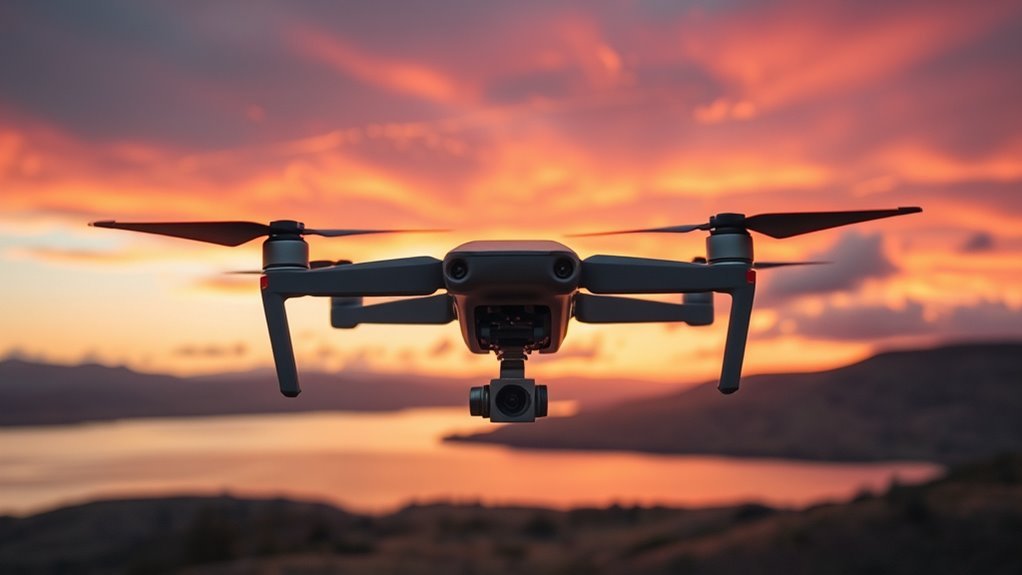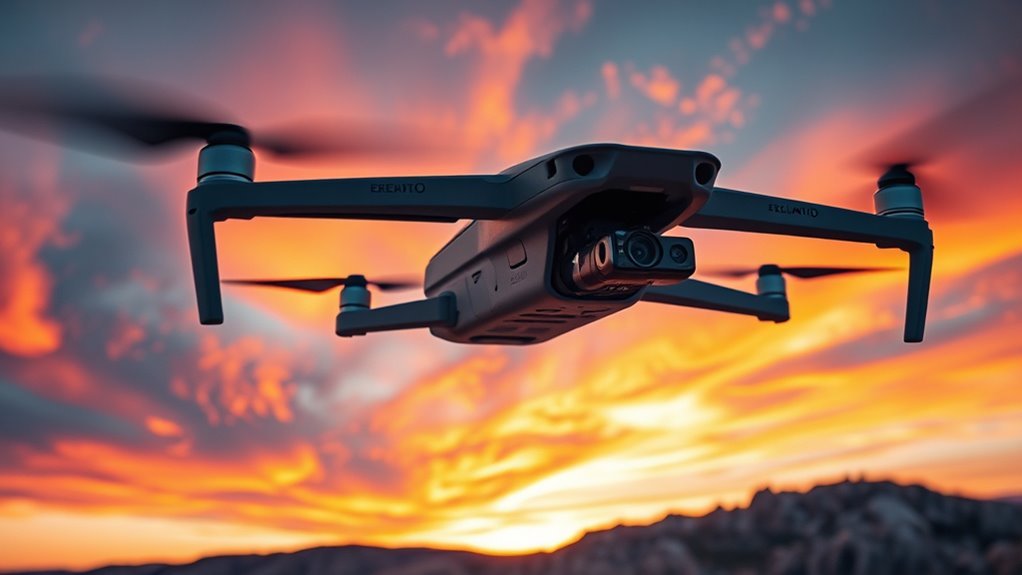A drone camera gimbal is a stabilization system that keeps your footage steady by isolating the camera from unwanted motion across pitch, roll, and yaw axes using motorized pivots and sensors. It counteracts vibrations and wind gusts in real time to guarantee smooth, jitter-free shots. Understanding the types, key components like brushless motors and IMUs, and how gimbals enhance aerial imagery will help you choose and maintain the right system for your drone’s needs.
What Is a Drone Camera Gimbal?

A drone camera gimbal is a stabilization device that guarantees your footage remains steady and smooth despite the drone’s movements or external vibrations. Its core functionality lies in isolating the camera from unwanted motion by counteracting shifts along multiple axes. The gimbal design typically incorporates motors and sensors arranged on a pivoting frame, allowing precise, real-time adjustments. This mechanical and electronic synergy assures the camera maintains a fixed orientation, granting you freedom to capture fluid visuals in dynamic environments. Understanding gimbal functionality means recognizing how its components work cohesively to neutralize tilting, rolling, and panning caused by flight. By mastering the intricacies of gimbal design, you gain control over your drone’s visual stability, ultimately elevating the quality and reliability of your aerial footage.
How a Gimbal Stabilizes Your Footage

Even when your drone encounters sudden movements or gusts of wind, the gimbal actively compensates to keep your camera steady. This is achieved through advanced gimbal mechanics that detect unwanted motion and counteract it instantly. The stabilization techniques employed involve motorized axes that pivot the camera independently of the drone’s movement, ensuring smooth footage. You gain freedom to capture cinematic shots without the distraction of jitters or shakes.
| Aspect | Function |
|---|---|
| Sensors | Detect angular velocity and motion |
| Motors | Adjust camera position in real time |
| Control Algorithms | Compute necessary corrections |
| Stabilization Axes | Pan, tilt, and roll for thorough control |
Understanding these elements lets you appreciate how gimbals deliver unwavering stability in dynamic environments.
Types of Drone Camera Gimbals

Now that you understand how gimbals stabilize footage through sensors, motors, and control algorithms, it’s important to recognize that not all gimbals operate the same way. There are primarily two gimbal types used in drones: 2-axis and 3-axis gimbals. The 2-axis design stabilizes pitch and roll, offering basic compensation but leaving yaw uncorrected, which might limit your aerial freedom. Conversely, 3-axis gimbal designs actively stabilize pitch, roll, and yaw, providing superior smoothness and allowing you full rotational freedom. Some advanced gimbals even integrate brushless motors for precise, silent operation. Depending on your drone’s purpose—whether casual shooting or professional cinematography—you’ll find specific gimbal types engineered for different stability needs and payloads. Understanding these gimbal designs empowers you to choose the ideal setup for unrestricted, fluid footage.
Key Components of a Drone Gimbal
Understanding the key components of a drone gimbal is essential for optimizing its performance and maintenance. At its core, gimbal mechanics rely on three motorized axes—pitch, roll, and yaw—that work in unison to counteract drone movement, ensuring steady footage. These brushless motors respond instantly to vibrations and shifts, stabilizing the camera in real-time. Central to this is the inertial measurement unit (IMU), which detects angular velocity and acceleration, feeding data to the stabilization technology’s control algorithms. This precise feedback loop allows the gimbal to execute micro-adjustments, preserving smoothness even during rapid maneuvers. Additionally, the frame and mounting system provide structural integrity while minimizing weight, granting you freedom to explore without compromising stability. Mastering these components empowers you to maintain and fully leverage your drone’s gimbal capabilities.
How to Choose the Right Gimbal for Your Drone
What factors should you consider when selecting a gimbal for your drone? First, evaluate compatibility factors such as your drone’s model, camera size, and mounting options to guarantee seamless integration. Next, consider the gimbal weight—it must be light enough to maintain your drone’s flight efficiency and battery life, yet robust enough to stabilize the camera effectively. Pay attention to the gimbal’s stabilization technology; brushless motors offer precise control and smooth footage, essential for capturing freedom in motion. Also, assess the degrees of freedom and payload capacity to match your camera’s specifications. By balancing these technical elements, you’ll achieve peak performance without compromising your drone’s agility, empowering you to explore creative aerial shots with confidence and ease.
Common Issues and Troubleshooting Tips
Selecting the right gimbal sets the foundation for smooth aerial footage, but even the best setups can encounter issues during operation. You might face gimbal calibration issues that cause jitter or drift, or battery power concerns leading to inconsistent stabilization. Address these promptly to maintain freedom in your flight.
| Issue | Cause | Solution |
|---|---|---|
| Gimbal Calibration | Sensor misalignment | Recalibrate via drone app |
| Motor Vibrations | Loose mount or debris | Tighten screws, clean gimbal |
| Battery Power Concerns | Low voltage or aging cells | Replace batteries, monitor charge |
Tips for Maintaining Your Drone Gimbal
To keep your drone gimbal performing at its best, you need to clean it regularly using appropriate tools to avoid damaging delicate components. Proper storage, including temperature and humidity control, prevents mechanical wear and sensor malfunctions. Additionally, staying up-to-date with firmware updates guarantees your gimbal operates with the latest stability and compatibility improvements.
Regular Cleaning Techniques
Maintaining your drone gimbal’s performance hinges on consistent cleaning, ideally after every few flights or exposure to dusty environments. Establishing a rigorous cleaning schedule is essential for effective gimbal maintenance. Use a soft, lint-free microfiber cloth to gently wipe the gimbal arms and camera housing, avoiding abrasive materials that might damage delicate sensors. Compressed air can dislodge fine particles from tight crevices without physical contact, preserving the gimbal’s balance and responsiveness. Avoid liquids unless specified by the manufacturer, and if needed, use isopropyl alcohol sparingly on the cloth—not directly on components. Regular inspections during cleaning help you identify wear or loose parts early, preventing malfunctions. By adhering to these precise cleaning techniques, you guarantee your drone’s gimbal remains agile, enhancing your freedom to capture smooth, stabilized footage every flight.
Proper Storage Practices
After cleaning your drone gimbal, how you store it can greatly impact its longevity and performance. Prioritize gimbal protection by choosing storage solutions that shield it from dust, moisture, and physical shocks. Use a dedicated hard case or padded bag with compartments to prevent unwanted movement. Avoid extreme temperatures and direct sunlight to maintain motor and sensor integrity.
| Storage Solution | Protection Level | Best Use Case |
|---|---|---|
| Hard Case | High | Transport, rugged use |
| Padded Soft Bag | Medium | Daily storage, light travel |
| Silica Gel Packets | Moisture Control | Long-term storage |
Implementing these practices guarantees your gimbal operates smoothly, preserving your freedom to capture flawless aerial shots.
Firmware Updates Importance
Firmware updates are vital for guaranteeing your drone gimbal performs at its best and stays compatible with the latest software advancements. These updates enhance firmware compatibility, fix bugs, and optimize stabilization algorithms, all essential for reliable footage. Pay attention to update frequency; regularly checking for new firmware guarantees your gimbal adapts to improvements and new drone models. Neglecting updates can cause performance issues or incompatibility with your drone’s control system.
To maintain peak performance, you should:
- Verify firmware compatibility before updating
- Follow manufacturer guidelines for update frequency
- Use official software tools to install updates
- Backup current settings before applying changes
- Monitor update release notes for critical fixes
Staying current empowers you to capture stable, high-quality footage without limitations.
How Gimbals Enhance Aerial Photography
Although flying a drone smoothly is essential, it’s the gimbal that truly stabilizes your camera, ensuring sharp, steady aerial shots. By compensating for motion dynamics such as wind gusts and drone maneuvers, the gimbal maintains precise orientation, allowing you to focus on aerial composition without worrying about unwanted shake or blur. This mechanical stabilization preserves the camera’s angle relative to the horizon, delivering fluid footage and accurate framing. With the gimbal’s ability to isolate vibrations and sudden movements, you gain creative freedom to execute complex flight paths and dynamic shots. Ultimately, the gimbal transforms raw drone movement into refined visual storytelling, empowering you to capture professional-quality aerial imagery that reflects your artistic intent and navigates challenging conditions with confidence.
Future Trends in Drone Gimbal Technology
You’ll see AI integration revolutionizing gimbal responsiveness by predicting motion patterns for smoother footage. Enhanced stabilization techniques will reduce vibrations and compensate for complex drone maneuvers more effectively. These advancements will greatly elevate the precision and reliability of aerial imaging systems.
AI Integration Benefits
As AI continues to advance, its integration into drone camera gimbals is set to revolutionize stabilization and image capture. You’ll benefit from smart stabilization that adapts dynamically to flight conditions through real-time analysis and data processing. Automated adjustments reduce manual input, letting you focus on creative freedom. Predictive tracking anticipates subject movement, ensuring fluid footage. AI-driven image enhancement elevates clarity and color accuracy. Flight optimization algorithms work seamlessly with gimbals to maintain smooth shots despite environmental challenges.
Key AI integration benefits include:
- Smart stabilization adapting to turbulence and speed
- Automated adjustments minimizing manual recalibrations
- Predictive tracking for seamless subject following
- Real-time analysis enhancing image quality instantly
- Flight optimization improving overall shot stability and precision
This tech empowers you to capture breathtaking visuals with less effort and greater control.
Enhanced Stabilization Techniques
When you rely on drone footage for professional-grade results, enhanced stabilization techniques are essential to overcoming the limitations of current gimbal systems. By leveraging advanced gimbal algorithms, your drone can predict and counteract complex movements in real-time, ensuring smoother, more precise camera positioning. Dynamic stabilization systems further elevate this by adapting to variable flight conditions, such as sudden gusts or rapid directional changes, without sacrificing image integrity. These innovations give you greater freedom to execute creative maneuvers while maintaining crisp, steady shots. As future trends evolve, integration of sensor fusion and machine learning will refine stabilization accuracy, minimizing latency and vibration artifacts. Embracing these technologies empowers you to push aerial cinematography boundaries without being constrained by mechanical or environmental instability.

